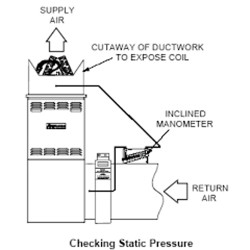
Measuring Airflow using Temperature Rise Method
The Temperature Rise Method (Sensible heat formula)
The temperature rise method may be used for fossil fuel and electric furnaces. However, because the heat content of natural gas varies from day to day and hour to hour, and fuel oil from tank to tank, the temperature rise method should only be used to get the airflow close to the manufacturer’s recommendation, and cannot be used for AC system capacity verification. To estimate CFM in a natural gas, propane or oil furnace, first let the furnace run for ten minutes or until the stack temperature stabilizes allowing the appliance to reach steady state efficiency.
Using a combustion analyzer determine the steady state operating efficiency of the appliance and multiply it times the BTUh input to get the output BTUh of the furnace. (Remember, if the heat is not going up the stack, it is going into the house.)
If a combustion analyzer is not available, alternatively, the manufacturer’s literature could be used to determine the output BTUh of the furnace provided the manifold pressure is correct and the orifices are designed for the heat content (BTUs) of the fuel used consistent with the design input of the furnace. It is typical for equipment to come with orifices that under-fire the equipment at design manifold pressure. Do not exceed the manufacturer's permissible guidelines when adjusting manifold pressure.
(Do not use efficiency information from the yellow energy guide label, as this is AFUE, (Annualized Fuel Utilization Efficiency) and takes into account the efficiency losses at start-up of the equipment.)
Next measure the temperature rise across the heat exchanger. CAUTION It is important that your probe be out of the line of sight of the heat exchanger when making these measurements as the temperature probe can be affected by radiant heat from the heat exchanger. If the furnace has a bypass humidifier, make sure the bypass is closed. Next enter your results into the sensible heat formula (shown below). This is an approximate method as the heat content of natural gas varies across the United States and even from the same meter from hour to hour, and there is additional heat added from the blower motor. Heat added by the motor can be as much as 300 watts or 1024 Btu.
NATURAL GAS/LIQUIFIED PETROLEUM (PROPANE)
CFM = (Input BTU x thermal efficiency) / (1.08 x DT)
Note: Combustion efficiency can be used in place of thermal efficiency.
DT is the temperature rise across the heat exchanger in degrees Fahrenheit
This will give you an approximate CFM; although it will be very close to the actual if the measurements are made accurately and the input of the appliance is correct.
ELECTRIC HEAT
For an electric furnace the airflow measurement procedure is the same. Allow the appliance to operate until the temperature rise stabilizes. Measure the temperature rise again out of the line of sight of the electric heater, along with the incoming volts and current draw in amps to the electric strip heaters. Enter the information into the following formula.
CFM = (Volts x Amps x 3.41) / (1.08 x DT)
FUEL OIL
For fuel oil the procedure involves verifying the nozzle size and the correct fuel pressure. After the Nozzle size in GPM (gallons per minute) is known and fuel pressure set, the combustion efficiency must be measured with a stable stack temperature, and the temperature rise across the heat exchanger recorded.
CFM = ((Btu/gal oil) x (Nozzle size GPH) x (combustion/thermal efficiency)) / (1.08 x DT)
